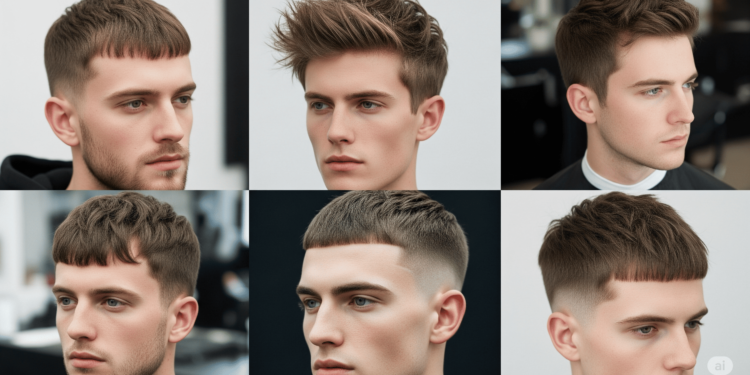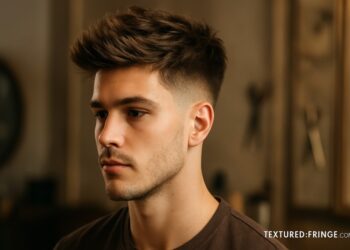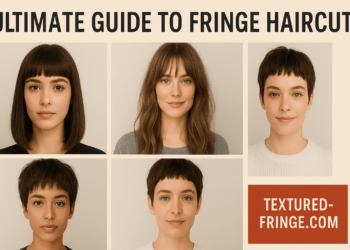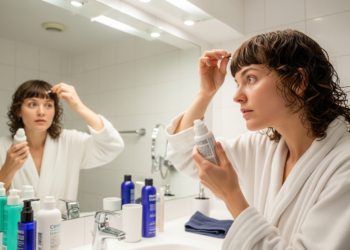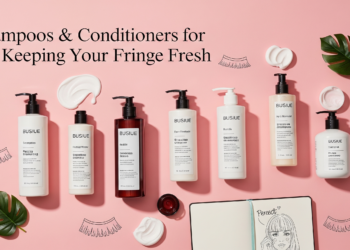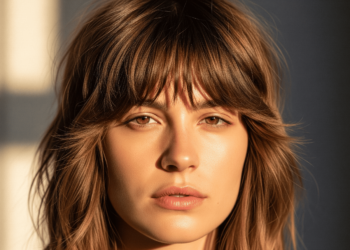The textured fringe has quietly become one of the most versatile and popular men’s hairstyles of recent years. Unlike the harsh, blunt cuts of the past, today’s textured fringe offers a sophisticated blend of structure and movement that works across different face shapes, hair types, and personal styles.
Whether you’re looking to add subtle dimension to your current look or make a bold statement with dramatic texture, there’s a textured fringe variation that can transform your appearance. Let’s explore the complete spectrum of options available.
What Makes a Fringe “Textured”?
Textured fringe differs from traditional straight-cut bangs through strategic layering and cutting techniques that create natural movement and dimension. Professional stylists use point-cutting, razor techniques, and varied lengths to break up the solid line of conventional fringes.
This approach prevents the hair from lying flat against the forehead, instead encouraging pieces to fall naturally at different angles. The result? A more organic, lived-in appearance that’s easier to style and maintains its shape longer between cuts.
The Subtle Spectrum: Understated Textured Fringes
Soft Textured Fringe
Perfect for conservative workplaces or men new to fringe styles, the soft textured fringe features minimal layering with gentle, graduated lengths. This style typically extends to mid-forehead level and blends seamlessly with longer top sections.
The texture remains subtle enough that it enhances your natural hair movement without screaming for attention. Most guys find this style incredibly low-maintenance – a quick finger-comb through damp hair often provides enough styling.
Styling tip: Use a lightweight styling cream on towel-dried hair, then air dry or use a diffuser on low heat.
Wispy Textured Fringe
The wispy variation takes subtlety even further by incorporating feather-light layers that create an almost effortless appearance. This style works exceptionally well for men with fine to medium hair density who want to add visual weight without bulk.
Wispy fringes often feature longer pieces mixed with shorter ones, creating natural separation that moves beautifully in any breeze. Think of it as the sophisticated cousin of the messy fringe – intentional yet relaxed.
Side-Swept Textured Fringe
Adding a directional element transforms the traditional fringe into something more dynamic. The side-swept textured fringe combines the best of both worlds: the face-framing benefits of a fringe with the mature sophistication of a side part.
This style requires slightly more length on one side to achieve the sweep, but the textured cutting prevents it from looking too formal or rigid. It’s an excellent transitional style for men moving from traditional side parts to more contemporary looks.
Medium Impact: Balanced Textured Styles
Choppy Textured Fringe
When you want more definition than subtle styles provide but aren’t ready for dramatic changes, choppy textured fringes hit the sweet spot. This technique involves more pronounced length variations and deeper point-cutting to create distinct pieces and movement.
The choppy approach works particularly well for men with thick, coarse hair that needs extra encouragement to move naturally. The varied lengths prevent the hair from forming a heavy, monotonous line across the forehead.
Styling becomes more important with choppier textures. A small amount of texturizing paste or clay helps define individual pieces while maintaining the natural, undone aesthetic.
Layered Textured Fringe
Incorporating multiple layers throughout the fringe section creates incredible depth and dimension. This technique involves cutting the hair at various lengths and angles to encourage natural falling patterns that look different from every viewing angle.
Layered textured fringes photograph beautifully and always appear to have movement, even in still images. They’re particularly flattering for men with round or square face shapes, as the varied lengths soften harsh angles.
Disconnected Textured Fringe
The disconnected approach creates intentional separation between the fringe and the hair behind it. Rather than blending seamlessly, there’s a deliberate contrast in length that makes the textured fringe the focal point of the entire hairstyle.
This style requires more commitment, as the contrast is quite noticeable and significantly changes your overall appearance. However, it offers maximum impact for the textured element and creates a distinctly modern, editorial look.
Bold Territory: Statement Textured Fringes
Heavy Textured Fringe
For men who want their fringe to make a statement, heavy textured styles deliver maximum impact. These cuts feature substantial length – often reaching the eyebrows or beyond – combined with aggressive texturing techniques that create dramatic movement and volume.
Heavy textured fringes work best on men with thick hair and strong facial features that can handle the visual weight. The key is ensuring the texture remains prominent enough to prevent the fringe from looking too heavy or overwhelming.
Professional styling becomes crucial with heavier fringes. Using the right products and techniques can mean the difference between looking deliberately edgy and accidentally messy.
Asymmetrical Textured Fringe
Asymmetry adds an avant-garde element that immediately sets your look apart from conventional styles. This approach involves cutting the fringe at deliberately uneven lengths – perhaps shorter on one side and longer on the other – while maintaining texture throughout.
The asymmetrical textured fringe requires confidence to pull off successfully, but it creates an undeniably unique appearance that photographs beautifully and works particularly well for creative professionals or men in fashion-forward industries.
Razor-Cut Textured Fringe
Using a razor instead of scissors creates the most dramatic texture possible in fringe cutting. This technique produces incredibly fine, feathered ends that move independently and create constant visual interest.
Razor-cut textured fringes have an almost ethereal quality – they appear to float and move with the slightest air current. This approach works best on men with naturally straight to slightly wavy hair, as the technique can make curly hair appear frizzy rather than textured.
The maintenance requirements are higher with razor-cut styles, as the fine ends can become damaged more easily and may require more frequent trimming.
Matching Textured Fringes to Face Shapes
Round Faces
Men with round faces benefit most from textured fringes that add length rather than width. Avoid heavy, straight-across cuts that emphasize the face’s circular nature. Instead, opt for side-swept or asymmetrical variations that create vertical lines and visual elongation.
Choppy or layered textures work particularly well, as they break up any horizontal emphasis while drawing attention upward toward the hairline.
Square Faces
Strong jawlines and angular features can handle bolder textured fringe styles. Heavy textured fringes actually complement square faces beautifully by adding softness to counterbalance sharp bone structure.
Avoid overly geometric cuts and instead embrace styles with organic, irregular texturing that softens the overall appearance.
Oval Faces
The versatility prize goes to oval face shapes, which can successfully wear virtually any textured fringe variation. This face shape provides the perfect canvas for experimenting with different texturing levels and styling approaches.
Consider your personal style and lifestyle demands when choosing from the full spectrum of options available.
Long Faces
Horizontal emphasis becomes important for elongated face shapes. Wider, fuller textured fringes help create the illusion of broader facial proportions while the texture prevents the look from appearing too heavy or artificial.
Avoid overly narrow or concentrated textured fringes that might accentuate length rather than providing balance.
Hair Type Considerations
Fine Hair
Men with fine hair often struggle with fringes that fall flat or lack presence. Textured cutting techniques can be incredibly beneficial here, creating the illusion of thicker, fuller hair through strategic layering and movement.
Lighter texturing works best – avoid overly aggressive cutting that might make fine hair appear sparse. Focus on creating gentle movement rather than dramatic contrast.
Thick Hair
Thick hair provides the perfect foundation for bold textured fringe styles. The natural volume and weight can support heavier texturing without losing shape or looking thin.
Consider more aggressive cutting techniques like razor work or deep point-cutting to really showcase the hair’s natural abundance while preventing it from becoming too bulky.
Curly Hair
Textured fringes on curly hair require special consideration. The natural curl pattern already provides texture, so cutting techniques should enhance rather than fight against the hair’s natural tendencies.
Work with a stylist experienced in curly hair cutting who understands how to create texture that complements rather than competes with natural curl patterns.
Wavy Hair
Wavy hair often produces the most photogenic textured fringe results. The natural movement provides an excellent foundation for texturing techniques, creating effortless-looking styles that photograph beautifully.
Medium-weight texturing typically works best, allowing the natural wave pattern to remain visible while adding intentional variation in length and movement.
Professional Styling Techniques
Blow-Drying Methods
Proper blow-drying technique can make or break a textured fringe. Start with towel-dried hair and apply your chosen styling product before any heat application.
Use a medium-sized round brush to lift sections of the fringe while directing airflow from root to tip. This creates volume at the base while encouraging the textured ends to fall naturally.
For more casual styling, try scrunching the hair while blow-drying with a diffuser attachment. This enhances natural texture without creating overly structured results.
Product Selection
The right products can dramatically improve how your textured fringe looks and behaves throughout the day. Lightweight styling creams work well for subtle textures, providing gentle hold without weighing the hair down.
For more pronounced textures, consider texturizing pastes or clays that enhance separation between individual pieces. Avoid heavy waxes or gels that can make textured cuts appear clumpy or artificial.
Sea salt sprays offer another excellent option, particularly for achieving that effortless, beach-tousled texture that looks naturally windswept.
Heat Styling Tools
Flat irons aren’t just for straightening – when used correctly, they can enhance textured fringe styling by creating subtle bends and movement. Use low heat settings and work in small sections to avoid damaging the hair or creating harsh lines.
Curling irons or wands can add gentle waves to straight hair, creating texture where none existed naturally. Choose barrel sizes that complement your fringe length – smaller barrels for shorter fringes, larger ones for longer styles.
Maintenance and Growing Out
Regular Trim Schedule
Textured fringes typically require trimming every 3-4 weeks to maintain their shape and movement. The exact timing depends on your hair growth rate and how precisely cut your particular style is.
More heavily textured styles may need attention slightly more frequently, as the contrast between different lengths becomes more noticeable as all sections grow out equally.
Growing Out Gracefully
Planning ahead makes growing out a textured fringe much more manageable. Discuss your long-term hair goals with your stylist so they can cut your fringe in a way that will transition smoothly as it grows.
Side-swept variations often grow out more gracefully than straight-across cuts, as the longer sections can be gradually incorporated into the overall hairstyle.
Seasonal Adjustments
Many men find their textured fringe needs seasonal adjustments to account for changes in humidity, styling routine, and personal preferences. Summer often calls for lighter, more manageable textures, while winter might accommodate heavier, more dramatic styles.
Consider how your lifestyle changes throughout the year and adjust your fringe accordingly.
Common Styling Mistakes to Avoid
Over-styling ranks as the most frequent error men make with textured fringes. The entire point of textured cutting is to create natural-looking movement, which gets lost when you use too much product or over-manipulate the hair with tools.
Using the wrong products can completely destroy a textured fringe’s intended effect. Heavy, glossy products make textured cuts look clumpy and artificial, while products with too much hold prevent the natural movement that makes these styles appealing.
Ignoring your hair’s natural growth patterns leads to constant styling frustration. Work with your stylist to understand how your hair grows and falls naturally, then choose texturing techniques that enhance rather than fight these patterns.
The Psychology of Textured Fringes
There’s something uniquely appealing about textured fringes that goes beyond mere aesthetics. The slight imperfection and organic movement suggest confidence and approachability – you’re put-together without appearing overly concerned with perfection.
Many men report feeling more relaxed and authentic with textured fringe styles compared to more rigid, geometric cuts. The natural movement creates a sense of ease that translates into how others perceive you.
Conclusion
Textured fringe haircuts offer an incredible range of possibilities for men seeking to refresh their look while maintaining sophistication and versatility. From subtle wispy styles that barely announce their presence to bold, statement-making cuts that completely transform your appearance, there’s a textured fringe variation perfectly suited to your lifestyle and personality.
The key lies in understanding your face shape, hair type, and personal style preferences, then working with a skilled stylist who understands textured cutting techniques. Remember that the best textured fringe is one that feels authentic to you – whether that means embracing subtle enhancement or diving headfirst into bold experimentation.
Take time to consider your styling commitment level and maintenance preferences before making your choice. With the right cut and proper care, a textured fringe can become the signature element that elevates your entire look from ordinary to extraordinary.
Frequently Asked Questions
How long does hair need to be for a textured fringe?
Most textured fringe styles require at least 2-3 inches of length at the front to work with. However, some subtle variations can be achieved with as little as 1.5 inches, while bolder styles might need 4+ inches for optimal results.
Will a textured fringe work with my receding hairline?
Textured fringes can actually be excellent for men with receding hairlines. The texture and movement help camouflage uneven hairlines, and strategic cutting can create the illusion of fuller coverage. Discuss your specific concerns with an experienced stylist.
How much time should I expect to spend styling a textured fringe daily?
Subtle textured fringes often require just 2-3 minutes of styling – simply working product through damp hair and letting it air dry. Bolder styles might need 5-10 minutes with blow-drying and more detailed product application.
Can I get a textured fringe if I have a cowlick?
Absolutely! Skilled stylists can work with cowlicks to create textured fringes that enhance rather than fight against your natural growth patterns. The key is choosing texturing techniques that complement your specific cowlick direction and strength.
What’s the difference between a textured fringe and a messy fringe?
Textured fringes use deliberate cutting techniques to create controlled, intentional variation in length and movement. Messy fringes rely more on styling products and techniques to achieve a disheveled appearance. Textured cuts look good even without heavy styling.
How do I know if a textured fringe will suit my professional environment?
Subtle textured fringes (soft, wispy, or gently side-swept) work well in most professional settings. Bolder variations like heavy or asymmetrical styles are better suited to creative fields or more relaxed work environments. When in doubt, start subtle and gradually increase texture over time.
What products work best for textured fringe styling?
Lightweight styling creams, texturizing pastes, and sea salt sprays are ideal for most textured fringe styles. Avoid heavy waxes, strong-hold gels, or anything that creates stiffness or excessive shine, as these work against the natural movement that makes textured fringes appealing.
Can I achieve textured fringe results at home?
While basic maintenance trimming is possible at home, creating the initial textured cut requires professional expertise. The cutting techniques used for texturing are complex and easy to get wrong. Invest in a professional cut, then maintain it with proper styling and occasional touch-ups.
How often will I need to get my textured fringe trimmed?
Most textured fringes need professional attention every 3-4 weeks to maintain their shape and movement. Some subtler styles can go 5-6 weeks, while heavily textured or precisely cut styles might need attention every 2-3 weeks.
Will a textured fringe make my face look rounder?
The impact depends on the specific style and your face shape. Side-swept and asymmetrical textured fringes typically add length to round faces, while straight-across heavy textures might emphasize width. Consult with your stylist about which textured approach best complements your features.
Can I combine a textured fringe with other trending hairstyles?
Textured fringes pair beautifully with many contemporary men’s styles including modern quiffs, textured crops, and even some fade variations. The key is ensuring the texturing techniques complement rather than compete with other elements of your cut.
What should I tell my barber to get the textured fringe I want?
Bring reference photos showing the specific texture level and style you prefer. Use descriptive terms like “subtle layering,” “choppy texture,” or “razor-cut ends.” Discuss your styling routine and maintenance preferences so your barber can tailor the cut accordingly.
